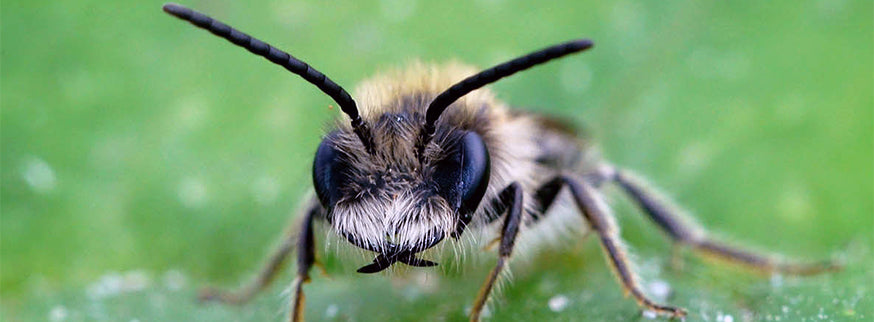
Diabetes and Bee Stings
What should you do if you get stung by a bee?
Summertime is here. Kids are out of school, the sun is shining bright, and outdoor fun and adventure have officially ramped up for those long summer days.
Yep! We’ve reached that glorious time of year when we get to spend a lot more time outdoors enjoying nature – whether it’s hiking, biking or just kicking back in the backyard. Summer is a wonderful season, but it’s also one that those living with diabetes need to pay particular attention to as exposure to that summertime heat can impact blood sugar control, lead to dehydration, and even affect insulin and other medications if they’re left out in the sun.
Being outdoors more often also means there’s a greater likelihood of experiencing a very common summertime hazard – the dreaded bee sting!
Before going any further, this blog is not about bashing the bees. We need the bees, and we appreciate the bees as an important part of nature’s delicate balance. But as people living with diabetes, we also need to be aware that the common bee sting may mean a little something more for us than for others.
What is a bee sting?
When a bee stings, it inserts its stinger into the skin. This stinger, even after it has been released from the bee and embedded in the skin, continues to release a venom called apitoxin, which is what causes the pain and burning sensation.
Getting stung by a bee is no fun for anyone. It hurts! But for most people when a bee stings, the pain is temporary and will likely be accompanied by some redness and swelling that dissipates relatively quickly – within a few hours of the sting. Of course, there are individuals who are allergic to bee stings, and for whom a single sting could lead to a dangerous, and even life-threatening reaction called anaphylaxis. That’s an entirely different risk than living with diabetes presents and often requires a person to carry an epi-pen as an emergency treatment in case of a sting.
Diabetes and bee stings
So, what’s the big deal with diabetes and bee stings? It comes down to the immune response. When a person is stung, it triggers an immune response from the body, and in some people with diabetes, especially if blood sugar has not been properly controlled, immune function can become compromised. This can both increase the severity of bee sting symptoms and increase the risk of a sting becoming infected. Some symptoms a bee sting might be more intense than usual include:
– Intense pain or burning
– Swelling or redness that extends beyond the sting site
– Hives or itching
– Difficulty breathing
– Dizziness
– Nausea or vomiting
What to do if you’re stung?
If you are someone you know with diabetes gets stung, it’s important to act immediately and do the following:
- Remove the stinger. To do so, use your fingernail or a credit card or driver’s license to scrape the stinger from the skin. It will not be deeply embedded. Do not use tweezers, as compressing the venom sack in the stinger can release more apitoxin into the body. It’s important to note that wasps, yellow jackets, and hornets do not leave a stinger in the body.
- Clean the area with soap and water to lower the risk of infection.
- Apply a cold compress to reduce pain and swelling.
- Watch for signs of a severe reaction following a sting, such as difficulty breathing, severe swelling or rapid heart rate. If these signs appear, seek medical attention right away.
- Check blood sugar following a bee sting as the stress of the experience and the level of pain might elevate blood sugar levels.
- Speak with your diabetes physician now! This way you’ll know what to do in case you get stung and experience a severe reaction or a spike in blood sugar. This includes any over-the-counter pain relievers or antihistamines you might be able to take to alleviate symptoms. Ask now before getting stung!
Can you avoid bee stings?
According to the Centers for Disease Control and Prevention (CDC), there are some things you can do to minimize the likelihood of getting stung. These include:
– Avoid perfumed soaps and shampoos, particularly banana-scented products, as they might attract bees.
– Wear clothing to cover as much of the body as possible.
– Bathe daily and wear clean clothes. The scent of sweat may anger bees.
– If a single bee is flying around you or even lands on you, remain calm and do not swat it as this may trigger a sting.
– If you are attacked by several wasps or hornets at once, run to get away from them! Do not attempt to jump into a pool or water as some bees, particularly Africanized Honeybees, are known to hover over the water waiting to sting you when you surface.
– Avoid flowering plants when possible.
– If a bee flies inside your vehicle, do not panic. Find a place to pull over, put the car in park and open all the windows. Chances are the bee wants out as bad as you want it out!
Takeaways
The fear of bee stings shouldn’t keep you from enjoying those sunny summer days. People with diabetes have no greater risk of experiencing a bee sting than anyone else. We do, however, have a slightly greater risk of having a more severe reaction and developing an infection, but proper care and close monitoring are enough to help avoid most serious concerns. So, keep your blood sugar under control with regular testing, a sound diet and physical activity program, and by following your doctor-prescribed treatment plan, and you should be just fine.
